Unexploded munitions in our seas

About 1.6 million tonnes of unexploded munitions from two world wars lie at the bottom of the North and Baltic Seas. These bombs, mines or even grenades threaten the marine environment, shipping, fishing and tourism. The German Environment Ministry (BMUV) launched an immediate action programme on unexploded munitions in the North and Baltic Seas to tackle this danger to the environment, health and safety.
About 1.6 million tonnes of unexploded munitions lie at the bottom of the North and Baltic seas, in German territorial waters alone. This represents a significant danger as their shells are slowly rusting or rotting. The munitions shells, most of which were sunk after the Second World War as part of the disarmament of Germany, are therefore increasingly difficult to locate, retrieve and dispose of.
More recent research has shown that substances arising from the explosives, some of which are carcinogenic and mutagenic, can accumulate in marine life such as mussels and fish. This is currently endangering the marine environment in particular. However, harmful substances from explosive compounds could also enter the human food chain this way in future.
Map of munitions dumps in the German North Sea and Baltic Sea
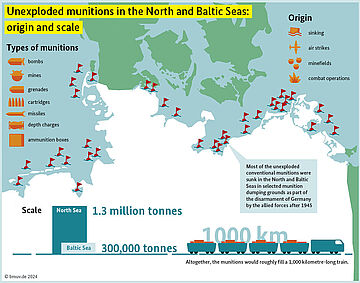
Steadily growing threat to the environment
This threat to the environment is growing from year to year. This is particularly problematic in the Baltic Sea as statistically its water is only renewed about every 100 years via a relatively small connection to the North Sea and Atlantic Ocean, the Skagerrak Strait. This means that the concentration of pollutants in the Baltic Sea accumulates over time. Munitions lying on the seabed or which have already sunk into the mud also pose a risk for shipping, fishing, tourism and the expansion of offshore wind power. The German government has therefore launched a multi-annual comprehensive immediate action programme to retrieve and dispose of unexploded munitions in German marine waters.
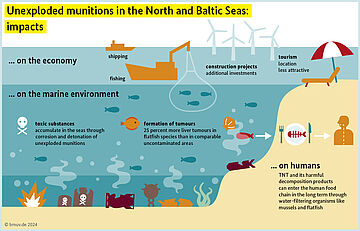
In a pilot project launched in summer 2024 under the immediate action programme, technologies already available for the systematic and automated detection and retrieval of different types of unexploded munitions were tested in selected areas in the Bay of Lübeck.
Infographic
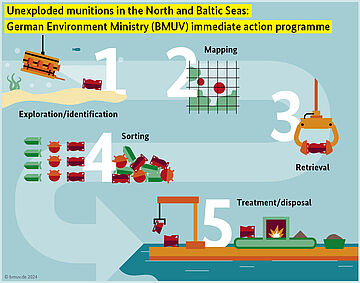
Unexploded munitions in the North and Baltic Seas: German Environment Ministry (BMUV) immediate action programme
In a first step, the area is explored and unexploded munitions identified. The area is then mapped out (2) and munitions retrieved (3). The munitions are sorted (4) and finally treated and disposed of (5).
Testing carried out in Bays of Lübeck and Mecklenburg
A large panel of experts selected suitable locations for testing off Haffkrug and Pelzerhaken (Bay of Lübeck) and Boltenhagen (Bay of Mecklenberg), as in these locations a wide range of different types of unexploded munitions can be found across a small area. Tests were carried out to determine which technologies are best for exploration and retrieval, and for which types of munitions in dense, large piles of unexploded munitions in the dumpsites. Munitions often build up in large piles on the seabed. The pilot project in the Bay of Lübeck has already shown that the technology used is highly suitable, but still needs to be further refined. The project has also provided valuable insights into the nature of the munitions and seabed contamination.
Map piloting in Lübeck and Mecklenburg Bight
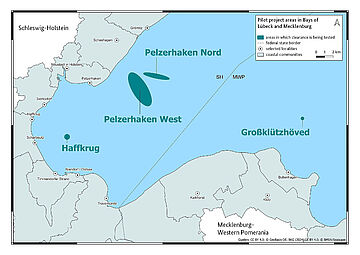
Pilot project areas in Bays of Lübeck and Mecklenburg
Areas in which clearance is being tested
Federal state border, Selected localities, Coastal communities, km, Schleswig-Holstein, Mecklenburg-Western Pomerania
The results of the pilot project will inform the development of a mobile and floating industrial facility to dispose of munitions at sea (for example by incineration). This facility will demonstrate how unexploded conventional munitions can be disposed of on site in an environmentally sound manner on a larger scale. This approach aims to test existing structural components and further develop them to provide the first efficient process chain for systematic, environmentally sound and nature‑friendly disposal at sea as part of a well thought-out overall concept. Many of the technologies used for the treatment and disposal of unexploded munitions, such as incineration and deactivation furnaces are already being used on land today. It is now important that this work is also carried out safely under the challenging conditions at sea.
The German government’s immediate action programme aims to demonstrate that it is possible to systematically clear large quantities of unexploded munitions in the German North and Baltic Seas. Actual implementation will be a generational task that the German federal and state governments will have to tackle together. 100 million euros have been made available from the federal budget for the immediate action programme.
The findings from the immediate action programme are also of great interest to other countries, as unexploded munitions that were dumped into seas are a growing problem in countless places around the world.
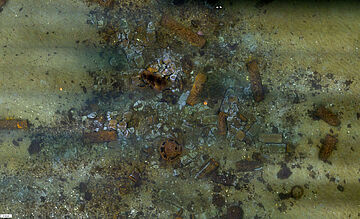
Pile of munitions with different munitions types at the Kolperger Heide dumping site.
Background
In the German North and Baltic Seas alone, two world wars have left behind approximately 1.6 million tonnes of unexploded munitions such as bombs, mines and grenades. These terrible legacies are roughly enough to fill a 1,000 kilometre‑long goods train – that is the distance by road from Berlin to Paris.
Most of the munitions, including smaller quantities of chemical weapons (such as mustard gas, sarin and tabun), were sunk in the seas by the allied forces as part of the disarmament of Germany after 1945. In addition, there are mines deployed during war at sea and unexploded ordnance from the bombardment of coastal areas.
